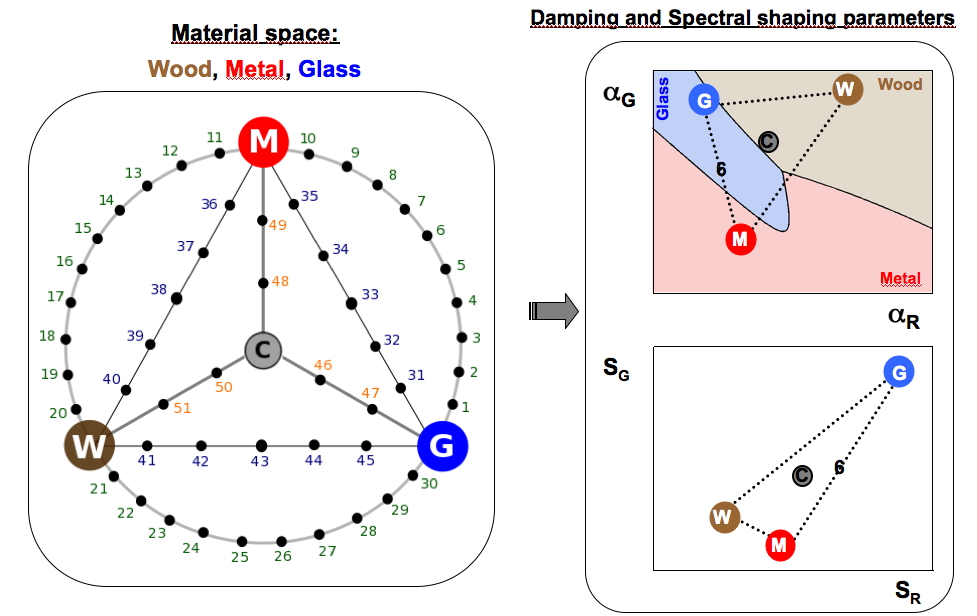| Sound 1 | original | synthesis | tuned |
| Sound 2 | original | synthesis | tuned |
| Sound 3 | original | synthesis | tuned |
| Sound 4 | original | synthesis | tuned |
| Sound 5 | original | synthesis | tuned |
| Sound 1 | original | synthesis | tuned |
| Sound 2 | original | synthesis | tuned |
| Sound 3 | original | synthesis | tuned |
| Sound 4 | original | synthesis | tuned |
| Sound 5 | original | synthesis | tuned |
| Sound 1 | original | synthesis | tuned |
| Sound 2 | original | synthesis | tuned |
| Sound 3 | original | synthesis | tuned |
| Sound 4 | original | synthesis | tuned |
| Sound 5 | original | synthesis | tuned |
Stimuli for sound categorization in schizophrenia
Sound continua were used to investigate disturbances of sound categorization in patients with schizophrenia.
A same experimental protocol based on a categorization task of the perceived material was conducted.
To shorten the duration of the experiment for patients, we reduced the previous sound corpus and selected the 3 following continua (one per transition):
1- Transition between wood and metal: Continuum #2
2- Transition between wood and glass: Continuum #1
3- Transition between glass and metal: Continuum #2
Importance of the spectral centroid (CSG ; related to the brighness) and the spectral bandwidth (SB) in sound categorization
Both CSG and SB have shown to be of little influence on the material
categorization. This can be illustrated by the following examples:
Sounds with identical CSG obtained by impacting objets of different
materials: GLASS
WOOD METAL
Sounds with identical SB obtained by impacting objets of different
materials: GLASS
WOOD METAL
Influence of damping and spectral complexity on material perception
The perception of materials mainly correlates with the damping of the
spectral components (sound examples can be heard
here or
here).
Nevertheless, damping cannot explain
by itself the material categorization.
We constructed
9 stimuli by independently combining
the spectra of typical sounds (of Wood, Metal or Glass) with the
damping characteristics of these sounds.
These stimuli
correspond to the 9 possible combinations between the 3 spectra and the
3 damping law characteristics of each material category.
| Wood damping | Metal damping | Glass damping | |
|---|---|---|---|
| Wood spectrum | |||
| Metal spectrum | |||
| Glass spectrum |
Participants
were asked to categorize these 9 sounds as Wood,
Metal or Glass.
Results confirmed that damping is not sufficient to
characterize the material categories and that both damping and the
spectral content of sounds are relevant cues for sound categorization.
Control of the perceived material in a sound synthesizer: "The Material Space"
Control of
sound dynamics (damping)
For impact sounds, sound dynamics is exclusively governed by damping.
A control of damping is proposed through the control of 2 parameters characterizing the frequency-dependent damping law.
The first parameter reflects global damping. The second one reflects the frequency-relative damping, i.e., difference between high frequency component damping and low frequency component damping.
The manipulation of these 2 parameters gives a refined control of the sound dynamics, allowing the synthesis of a wide variety of realistic sounds.
Control of spectral shaping
Two strategies are proposed to control the spectral shaping:
- spectral dilation. This control is provided by using 2 parameters. The first parameter reflects global shaping. The second one reflects the relative shaping.
- amplitude and frequency modulations. This control is provided by acting on modulation index I and the value of the modulating frequency.
The spectral shaping control can also be applied locally on a specific frequency range of the original spectrum by using a window function W.
Sounds corresponding to the numbered position illustrate the navigation in the Material space:

1- Transition between Wood and Metal
along the circle : W 20 19 18 17 16 15 14 13 12 11 M
straight
: W 40 39 38 37 36 M
through the center : W 51 50 C 48 49 M
2- Transition between Wood and Glass
along the circle : W 21 22 23 24 25 26 27 28 29 30 G
straight
: W 41 42 43 44 45 G
through the center : W 51 50 C 46 47 G
3- Transition between Glass and Metal
along the circle : G 1 2 3 4 5 6 7 8 9 10 M
straight
: G 31 32 33 34 35 M
through the center : G 47 46 C 48 49 M
Control strategy based on damping and amplitude modulation:
Transition between Glass and Metal: Glass » Step 1 » Step 2 » Step 3 » Step 4 » Metal
Sound effects: Glass » Cracked glass